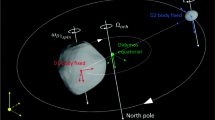Abstract
This work explores the target selection and trajectory design of the mission candidate for ISAS/JAXA’s small science satellite series, DESTINY PLUS or DESTINY+. This mission combines unique aspects of the latest satellite technology and exploration of transition bodies to fill a technical and scientific gap in the Japanese space science program. The spacecraft is targeted to study the comet-asteroid transition body (3200) Phaethon through a combination of low-thrust propulsion and Earth Gravity Assist. The trajectory design concept is presented in details together with the launch window and flyby date analysis. Alternative targets for a possible mission extension scenario are also explored.













Similar content being viewed by others
References
Battin, R.H.: An Introduction to the Mathematics and Methods of Astrodynamics. AIAA Education Series, Reston (1999)
Dymock, R.: The H and G magnitude system for asteroids. In: The BAA Observers’ Workshops, Journal of the British Astronomical Association, vol. 117, pp. 342–343 (2007)
Foing, B., Racca, G., Marini, A., et al.: Smart-1 mission to the moon: Technology and science goals. Adv. Space Res. 37(1), 6–13 (2006). doi:10.1016/j.asr.2005.12.016
Gill, P.E., Murray, W., Saunders, M.A.: Snopt: An sqp algorithm for large-scale constrained optimization. SIAM J. Optim. 12(4), 979–1006 (2002)
Gill, P.E., Murray, W., Saunders, M.A.: User’s Guide for SNOPT Version 7, Software for Large-Scale Nonlinear Programming. Stanford Business Software Inc., www.sbsi-sol-optimize.com (2006)
Jewitt, D., Li, J.: Activity in geminid parent (3200) phaethon. Astron. J. 140(5), 1519–1527 (2010). doi:10.1088/0004-6256/140/5/1519
Jewitt, D., Li, J., Agarwal, J.: The dust tail of asteroid (3200) phaethon. Astrophys. J. Lett. 771(2), L36 (2013). doi:10.1088/2041-8205/771/2/L36
Jorba, A., Zou, M.: A software package for the numerical integration of odes by means of high-order taylor methods. Exp. Math. 14, 99–117 (2005)
Kawaguchi, J., Fujiwara, A., Uesugi, T.: Hayabusa - its technology and science accomplishment summary and hayabusa-2. Acta Astronaut. 62(10–11), 639–647 (2008). doi:10.1016/j.actaastro.2008.01.028
Kawakatsu, Y., Itawa, T.: Destiny mission overview: a small satellite mission for deep space exploration technology demonstration. Amer. Astronaut. Soc. 146 (2012)
Rayman, M.D., Varghese, P., Lehman, D.H., Livesay, L.L.: Results from the deep space 1 technology validation mission. Acta Astronaut. 47(2–9), 475–487 (2000). doi:10.1016/S0094-5765(00)00087-4
Sarli, B.V., Kawakatsu, Y.: Selection and trajectory design to mission secondary targets. Celest. Mech. Dyn. Astron. Under Rev (2016)
Sarli, B.V., Ozaki, N., Yam, C., Sugimoto, Y., Campagnola, S., Chen, H., Nakajima, S., Ogura, S., Funase, R., Kawakatsu, Y., Nakasuka, S.: Procyon mission: A micro spacecraft to asteroid. In: 65Th Astronautical Congress, Toronto (2014)
Sarli, B.V., Kawakatsu, Y., Arai, T.: Design of a multiple flyby mission to the phaethon–geminid complex. J. Spacecr. Rocket. 52(3), 739–745 (2015). doi:10.2514/1.A33130
Sims, J.A., Finlayson, P.A., Rinderle, E.A., Vavrina, M.A., Kowalkowski, T.D.: Implementation of a low-thrust trajectory optimization algorithm for preliminary design. In: AIAA/AAS Astrodynamics Specialist Conference (2006)
Vallado, D.A.: Fundamental of Astrodynamics and Applications, 3rd edn. Microcosm Publishing, Portland (2007)
Yam, C.H., Kawakatsu, Y.: Gallop: A low-thrust trajectory optimization tool for preliminary and high fidelity mission design. In: 30th International Symposium on Space Technology and Science, vol ISTS 2015-d-49. Kobe (2015)
Yam, C.H., Izzo, D., Biscani, F.: Towards a high fidelity direct transcription method for optimisation of low-thrust trajectories. In: International Conference on Astrodynamics Tools and Techniques (ICATT) (2010)
Author information
Authors and Affiliations
Corresponding author
Appendix: Optimization Results
Appendix: Optimization Results
Tables 6, 7, 8, and 9 present the optimized cases for each structure analyzed on the EARTH-TO-PHAETHON OPTIMAL TRAJECTORIES section. In the following Tables 6, 8, and 9: the fist column is the number of the simulated case, the second column are the bounds in days for the Earth escape date. Columns three to five are the bounds in days for the flyby events of each body in the structure sequence (columns three to four in Table 7 - the problem structure has one swing-by less). The sixth column shows the final mass (column five in Table 7). Columns seven to ten present the dates of each flyby event, these dates correspond to the bounds from columns three to five (columns six to nine in Table 7).
Rights and permissions
About this article
Cite this article
Sarli, B.V., Horikawa, M., Yam, C.H. et al. DESTINY+ Trajectory Design to (3200) Phaethon. J of Astronaut Sci 65, 82–110 (2018). https://doi.org/10.1007/s40295-017-0117-5
Published:
Issue Date:
DOI: https://doi.org/10.1007/s40295-017-0117-5




